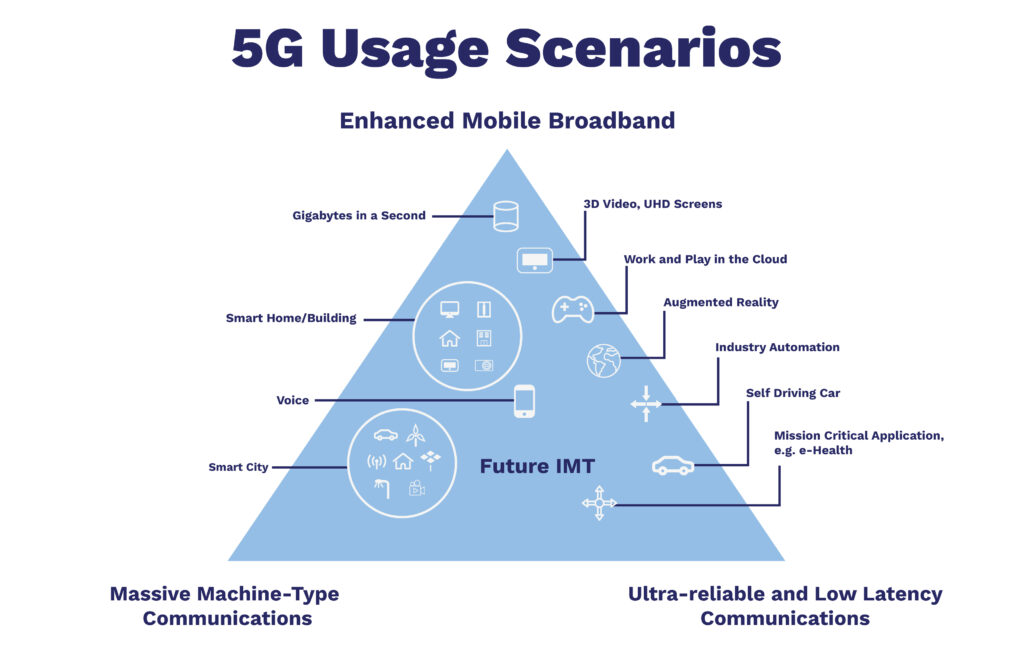5G, or fifth-generation wireless networks, standards work began in the early 2010s with the ambition to change the world. But looking back 10-15 years after its inception and five years after its first deployment, it would be more accurate to describe 5G as a transitional technology for the next generation rather than a world-changing one.
Unlike previous generations, which were developed as telecommunications standards, 5G was intended to be an industry standard. In previous generations, expectations were defined by mobile operators and manufacturers without much distinction between consumer and industrial needs. For 5G, however, representatives from all industries were consulted to identify the applications they envisioned by 2030 and the expectations they had from communication technologies to support them. The International Telecommunications Union (ITU) translated these “usage scenarios” into technical requirements in a standard document called IMT 2020. The results of this study were visualized with the most popular graphic associated with 5G, the triangle.

The three corners of this triangle represent the key technical pillars defining 5G according to IMT 2020 requirements:
- At the top is Enhanced Mobile Broadband (eMBB), targeting data speeds of up to 10 Gb/s, compared to 100 Mb/s in 4G. With such speed, downloading movies would take seconds, enabling applications like multiplayer gaming, distributed music recording, and holograms. eMBB is the only pillar that represents a natural continuation of consumer-oriented features from 4G.
The other two pillars focus more on industrial use:
- Massive Machine-Type Communications (mMTC) envisions supporting up to one million IoT devices per square kilometer, compared to just one thousand in 4G. This feature is essential for smart homes, smart cities, agriculture, and healthcare applications.
- Ultra-Reliable Low Latency Communications (uRLLC) guarantees reliable delivery of data with latency as low as 1 millisecond. 4G offered no such guarantee—delays ranged from 40 milliseconds to 1 second, with only “best effort” delivery. This capability is crucial for applications like autonomous vehicles and remote medical operations.
The 3GPP organization, tasked to develop the detailed standards for GSM, planned to release the standards in four versions (starting with Release 15) at intervals of 1-2 years. The first release had an “early release” in 2017, a full release in 2018, and commercial use began in 2020. In addition to the fundamental features of 5G expressed by the three pillars mentioned above, the additional capabilities it promises, which can be described as a ‘quantum leap’ compared to 4G, are listed in the box.

5G Deployments Worldwide
Deploying 5G infrastructure and commercializing 5G-based applications require massive investment. To reduce initial capital expenditure, the first release introduced a more affordable alternative, Non-Standalone (NSA) 5G, to full Standalone (SA) 5G deployment. However, this approach, combined with the financial crisis, laid the foundation for the current sense of underwhelming progress and unfulfilled expectations.
Modern mobile networks consist of two main components: a centralized Core Network and a distributed Radio Network composed of data centers and base stations. Because 5G’s Core and Radio Networks differ significantly from 4G’s, and require high initial investment, a transitional solution was created:
- Standalone (SA) configuration: Both Core and Radio Networks are entirely 5G-specific.
- Non-Standalone (NSA) configuration: The existing 4G Core and Radio Networks remain, and 5G base stations attached to 4G base stations enable limited 5G features.
As of February 2025, 341 mobile operators in 127 countries offer 5G services. Yet only 70 operators have deployed SA 5G. The rest have opted for NSA 5G, offering what is essentially 4G+, with faster internet speeds but with limited support for advanced industrial use cases. With the global economic crisis, operators that invested in NSA networks face difficulties financing a second investment round. Without investment, industrial applications cannot emerge, but without industrial applications, it’s hard to justify investment—a classic chicken-and-egg problem. Broad coverage is essential for customer revenue, which in turn funds investment.
6G Developments
Delays in 5G positioned 6G as the generation expected to fulfill unmet 5G promises. Unlike the radical technological leap between 4G and 5G, 6G is expected to evolve from 5G. The ITU defined technical requirements in the IMT-2030 document. 3GPP is expected to begin standardization efforts soon, with the first implementations likely in 2030, aligned with Release 21.
6G will emphasize:
- Coverage
- Sustainability
- Pervasive AI
- Integrated sensing
- Security and privacy
The first three 6G scenarios extend the pillars of 5G, into a hexagon:

- Enhanced Mobile Broadband (eMBB) evolves into Immersive Communication, providing interactive, rich video experiences, XR, telepresence, and holographic communication.
- mMTC becomes Dense Communication, connecting vast numbers of devices in smart cities, transportation, logistics, healthcare, agriculture, etc.
- uRLLC evolves into Hyper-reliable, Low-Latency Communication, enabling full automation, control, and operation in industrial environments, supporting machine interaction, emergency services, telemedicine, and power transmission monitoring.
New Scenarios:
- Ubiquitous Connectivity: Closing the digital divide, especially in rural and remote areas, enabling IoT, mobile broadband, and access for farmers, hikers, etc.
- AI and Communication Integration: Supporting autonomous collaboration between devices, reducing the need for heavy device processing, enabling predictive modeling via digital twins.
- Integrated Sensing and Communication: Enhancing navigation, AI, XR, activity detection, motion tracking, environmental monitoring, and other sensor-reliant applications.
Conclusion
While 5G was initially heralded as a revolutionary leap in wireless technology, its deployment so far has largely been evolutionary, constrained by financial challenges leading to transitional network architectures. The promise of 5G’s transformative impact, particularly in industrial and IoT applications, remains largely unrealized due to the slow rollout of standalone networks and the inherent chicken-and-egg dilemma faced by operators and industries alike. However, the foundation laid by 5G, including its diverse use cases and technical pillars, sets the stage for future advancements.
Looking ahead, 6G aims to build on and extend 5G’s capabilities with a stronger emphasis on sustainability, pervasive AI, integrated sensing, and security. 6G is poised to deliver a more holistic and connected experience, addressing current gaps and expanding wireless technology’s role in daily life and industry. The ongoing evolution from 5G to 6G signals a long-term journey toward truly ubiquitous, intelligent, and immersive connectivity that could finally fulfill the ambitious vision set over a decade ago.



